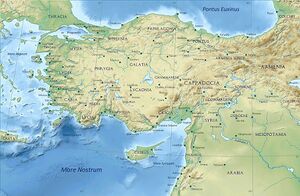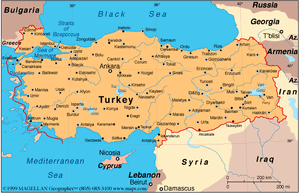Ordu
| Author:Laxman Burdak, IFS (R) |


Ordu or Altınordu is a port city on the Black Sea coast of Turkey, historically also known as Cotyora or Kotyora (Pontic: Κοτύωρα), and the capital of Ordu Province.
Variants
- Altınordu
- Cotyora (Pliny.vi.4)
- Cotyorum (Pliny.vi.4)
- Kotyora
- Pontic: Κοτύωρα
- Cytora (Κύτωρα)
Jat Gotras Namesake
- Gotiya = Cotyora (Pliny.vi.4)
- Chotia = Cotyora (Pliny.vi.4)
Jat Places Namesake
- Kotani = Cotyora (Pliny.vi.4), Kotani is village in Panipat, Haryana.
- Katana = Cotyora (Pliny.vi.4), Katana is village in tahsil Payal of district Ludhiana in Indian Punjab.
Jat Gotras Namesake
Name
Kotyora, the original name of the city is a legacy of indigenous Colchians. The name is allegedly composed of an old Laz word for pottery ('Koto', similar to Mingrelian 'Koto', Georgian 'Kotani' and Laz 'Katana') and a common Kartvelian suffix indicating belonging ('Uri'). In Zan (aka Colchian) Kotyora means a place where pottery is made.[1] This point is supported with several other Kartvelian place names existing in the region as well as the region itself historically being known as Djanik (Djani being another name for Laz).[2]
The contemporary name of Ordu meaning 'army camp' in Ottoman Turkish was adopted during the Ottoman Empire because of an army outpost being located near the present day city.
History
In the 8th century BC, Cotyora (Κοτύωρα) was founded by the Miletians as one of a string of colonies along the Black Sea coast. The Diodorus Siculus write that it was a colony of the Sinopians.[3] Xenophon's Anabasis relates that the Ten Thousand rested there for 45 days before embarking for home.[4][5][6] Strabo also mentions it.[7] Under Pharnaces I of Pontus, Cotyora was united in a synoikismos with Cerasus.[8] Arrian, in the Periplus of the Euxine Sea (131 CE), describes it as a village "and not a large one."[9] Suda mentioned that it was also called Cytora (Κύτωρα).[10]
The area came under the control of the Danishmends, then the Seljuk Turks in 1214 and 1228, and the Hacıemiroğulları Beylik in 1346. Afterwards, it passed to the dominion of the Ottomans in 1461 along with the Empire of Trabzon.[11]
The modern city was founded by the Ottomans as Bayramlı near Eskipazar as a military outpost 5 km west of Ordu.
In 1869, the city's name was changed to Ordu and it was united with the districts of Bolaman, Perşembe, Ulubey, Hansamana (Gölköy), and Aybastı. At the turn of the 20th century, the city was more than half Christian (Greek and Armenian), and was known for its Greek schools.[12]
On the 4th of April 1921, Ordu province was created by separating from Trebizond Vilayet.[13]
Archaeology
In 2016, archaeologist discovered a marble statue of Cybele. In 2018, at the same site, they also discovered sculptures of Pan and Dionysus.[14] In 2021, archaeologists complained because a stone quarry used dynamite destroying some of the rock tombs.[15]
In December 2021, archaeologists announced 1600 year-old eight tombs in the Kurtulus district of Ordu. Researchers also uncovered human and animal remains, many pieces of jewelry made of gold, sardine stone, silver, glass, and bronze, a glass bottle and beads.[16][17]
Mention by Pliny
Pliny [18] mentions...We find here the nations of the Genetæ7 the Chalybes8, the town of Cotyorum9, the nations of the Tibareni and the Mossyni, who make marks upon their bodies,....
7 Strabo speaks of a promontory called Genetes; and Stephanus Byzantinus mentions a river and port of the same name.
8 Strabo places the Chaldei, who, he says, were originally called Chalybes, in that part of the country which lies above Pharnacia (the modern Kerasunt).
9 Or Cotyora. According to Xenophon, this was a colony of Sinope, which furnished supplies for the Ten Thousand in their retreat. The place was on a bay called after the town. Hamilton, in his Researches, &c., Vol. i., is of opinion that Cotyorum may have stood on the site of Ordou, where some remains of an ancient port, cut out of the solid rock, are still visible. He remarks, however, that some writers suppose that Cotvora was the modern bay of Pershembah, which is more sheltered than Ordou. Cotyora was the place of embarkation of the Ten Thousand.
References
- ↑ Özhan Öztürk. Pontus, Antikçağ'dan Günümüze Karadeniz'in Etnik ve Siyasi Tarihi, Genesis Yayınları. Ankara 2011, S.492
- ↑ Özhan Öztürk. Pontus, Antikçağ'dan Günümüze Karadeniz'in Etnik ve Siyasi Tarihi. Genesis Yayınları. Ankara 2011. S.566
- ↑ Diodorus Siculus, Library, § 14.31.1
- ↑ Olshausen, Eckart, "Cotyora" in Brill's New Pauly, Antiquity doi:10.1163/1574-9347_bnp_e621460
- ↑ Anabasis V.5.3f
- ↑ Encyclopedia Britannica Eleventh Edition, s.v. Ordu
- ↑ XII.3.17
- ↑ Olshausen, Eckart, "Cotyora" in Brill's New Pauly, Antiquity doi:10.1163/1574-9347_bnp_e621460
- ↑ Anabasis V.5.3f
- ↑ Suda, ka.2170
- ↑ "Ordu ili tarihi". www.karalahana.com.
- ↑ Encyclopedia Britannica Eleventh Edition, s.v. Ordu
- ↑ "Karadeniz Ansiklopedisi: Ordu maddesi". www.karalahana.com.
- ↑ Dionysus, Pan sculptures found at site of 2,100-year-old goddess Kybele in northern Turkey
- ↑ Ancient castle under threat of quarry
- ↑ "4th-century tombs unearthed near Turkey's Black Sea coast". www.aa.com.tr.
- ↑ "1,600-Year-Old Tombs Uncovered in Northern Turkey - Archaeology Magazine". www.archaeology.org.
- ↑ Natural History by Pliny Book VI/Chapter 4
Back to Jat Places in Turkey

